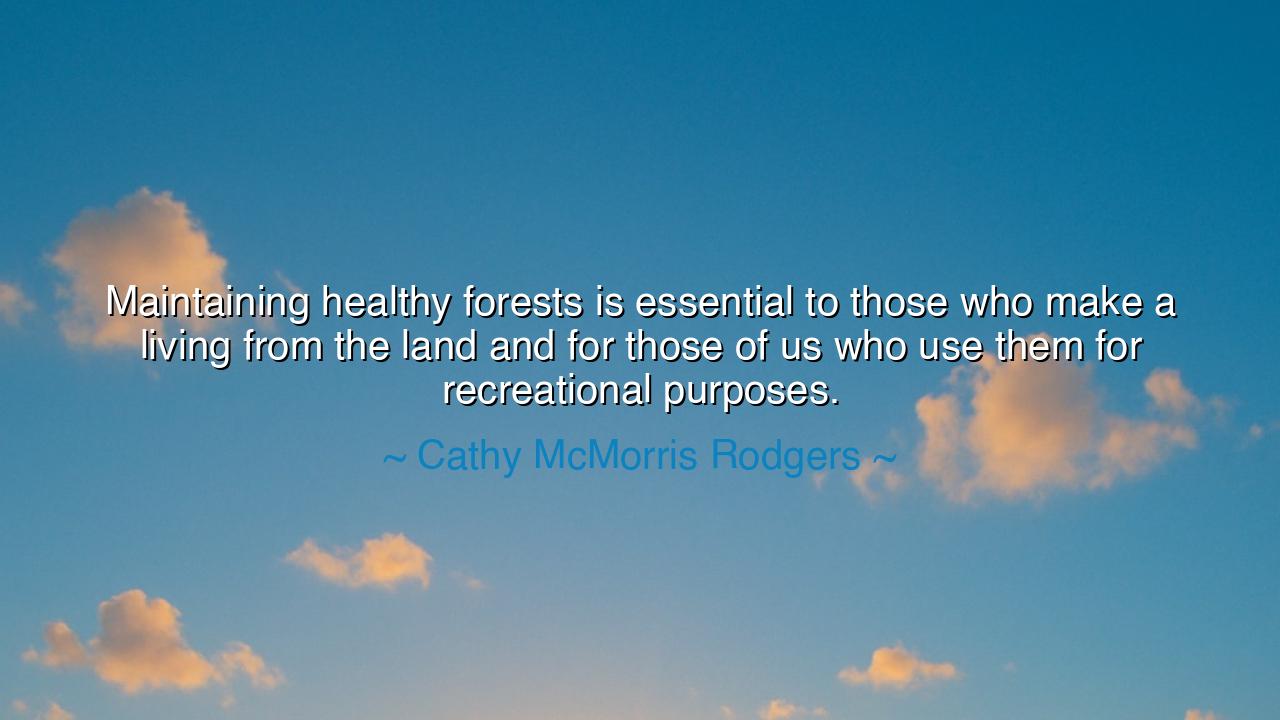
Maintaining healthy forests is essential to those who make a
Maintaining healthy forests is essential to those who make a living from the land and for those of us who use them for recreational purposes.






In the hush beneath tall crowns, Cathy McMorris Rodgers gives a plain but ringing truth: “Maintaining healthy forests is essential to those who make a living from the land and for those of us who use them for recreational purposes.” Hear how the sentence binds two camps with one cord—worker and wanderer, the mill and the meadow, the paycheck and the picnic. A forest is not merely scenery; it is a living workshop of light and water, root and rot, turning yesterday’s leaf-fall into tomorrow’s livelihood and solace. When the woodland thrives, both table and spirit are fed.
To say essential is to speak of foundations, not luxuries. The logger’s careful cut, the rancher’s shaded creek, the mushroom-hunter’s hidden trail, the guide’s quiet campsite—each depends on canopies that breathe, soils that sponge, streams that remember snow. Maintaining healthy forests means stewarding the slow alchemy of the understory: thinning where fuel has piled like tinder-prayer, letting good fire return in measured seasons, keeping roads from bleeding silt, leaving old giants and deadwood where owls and beetles make their kingdoms. Such care is not a tax on prosperity; it is the grammar of its continuance.
Consider a lamp from the northern mountains: the Big Burn of 1910, when wind drove flame across Idaho and Montana and the sky turned to coal at noon. Towns were saved by heroism, but the lesson was written in ash. For decades afterward we smothered every spark, and the forests grew dense with unspent fire. Now, with wisdom relearned, communities tune the woods like instruments—selective harvests, prescribed burns, shaded fuel breaks—so that when lightning speaks, the forest answers with low song rather than scream. In that measured music, mills can plan, trails stay open, and smoke does not exile the summer.
Lift another lamp: watersheds forested with intention. Where slopes wear green armor and riparian roots stitch the banks, the river runs clear for fishers and farmers alike. Tourists come for the wild chorus—solitude, birdsong, the clean cold of a plunge pool—and local shops hum because the forest is their year-round patron. Thus the recreational purposes loved by towns—angling, hiking, hunting, skiing—are not in rivalry with those who make a living from the land. When the canopy is kept whole and the cuts are made like surgeons, both ledger and laughter grow.
The origin of this wisdom is older than our politics. Monks once tallied trees like prayers; alpine villages practiced nachhaltigkeit, sustained yield, taking no more than the hillside could give back before the grandchildren’s turn. In every century the rule proves itself: treat the forest as a partner, not a quarry. Where greed fells faster than growth, floods come, soils flee, jobs vanish, and the trailhead grows silent. Where patience guides the saw and fire is used as tool, the forest pays interest—boards for building, berries for baskets, shade for cattle, quiet for the heart.
What, then, shall we do? Bind management to humility and measurement. Map fuels and thin with purpose; return good fire where it belongs; keep invasive species at the gate; repair culverts so salmon and stormwater both pass freely; certify harvests that honor the whole web, from mycorrhiza to elk. Fund trail crews and the small mills that turn local logs into local livelihood. Pay for what the forest provides but does not invoice—clean water, clean air, cool evenings—and let those payments strengthen the hands that keep the woods alive.
Carry this teaching like a trail charm: if you use the forest, help maintain it. If you earn from it, earn as if it must feed your children twice. Join a burn-prep day; pack out what others forgot; plant natives where erosion has gnawed; learn the signs of drought-stress and beetle-blight; vote for budgets that keep rangers in the field and graders on the roads. For only when healthy forests stand—resilient, diverse, well-tended—will the saw sing honestly, the stream run sweetly, and the footpath keep its promise to every traveler who steps beneath the green cathedral and calls it home.






AAdministratorAdministrator
Welcome, honored guests. Please leave a comment, we will respond soon